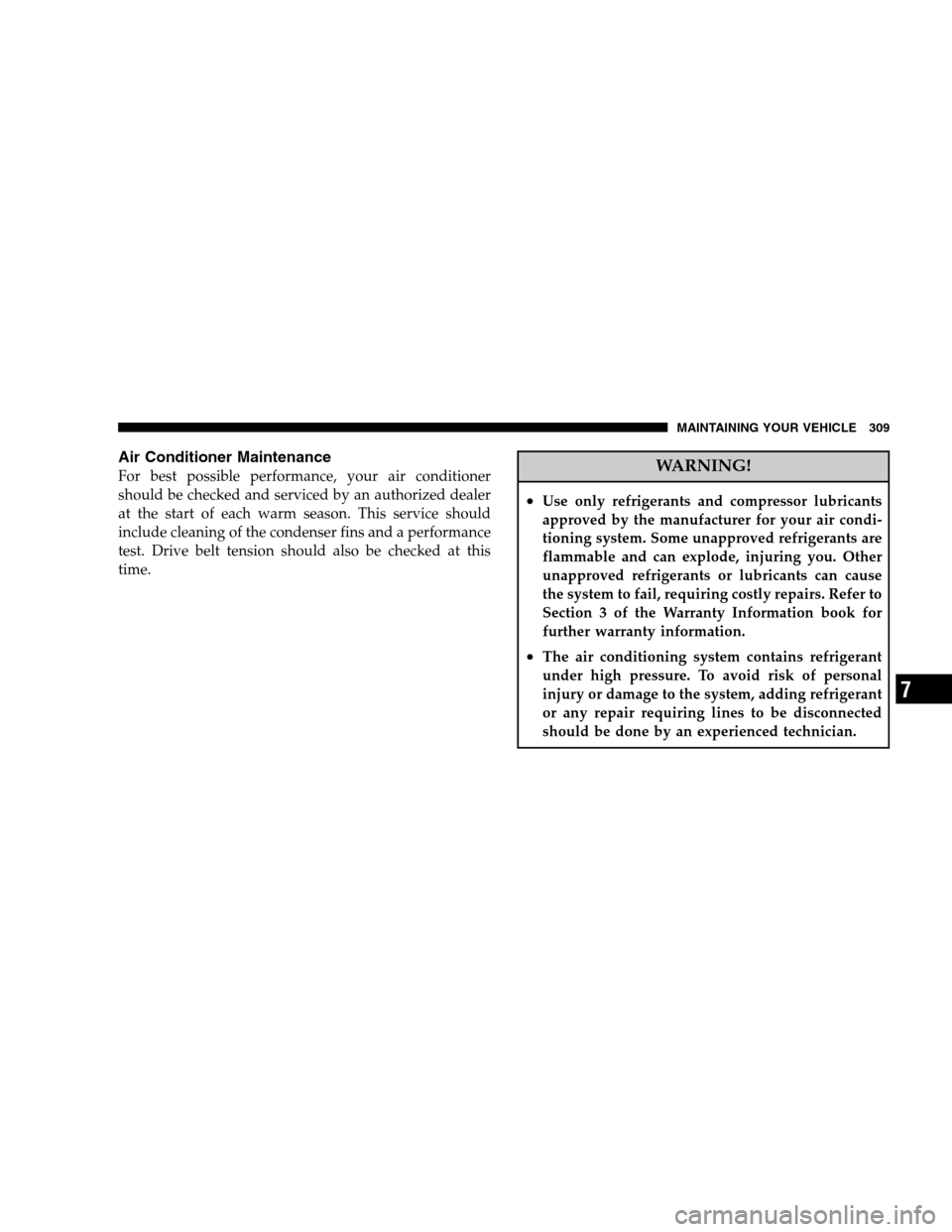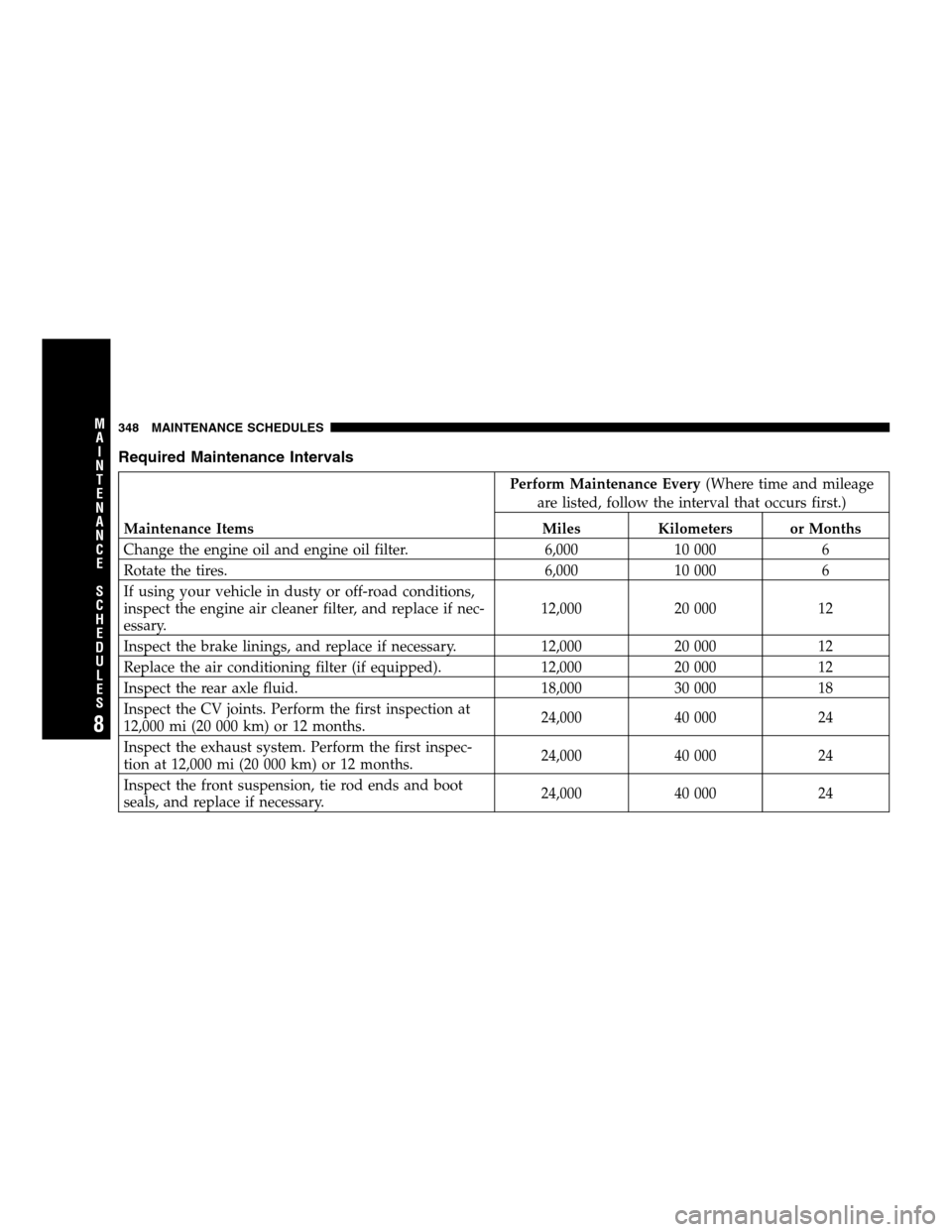2009 DODGE CHALLENGER SRT air conditioning
[x] Cancel search: air conditioningPage 281 of 381

NOTE:There are steps that you can take to slow down
an impending overheat condition. If your air conditioner
is on, turn it off. The air conditioning system adds heat to
the engine cooling system and turning off the A/C
removes this heat. You can also turn the Temperature
control to maximum heat, the Mode control to floor, and
the Fan control to HI. This allows the heater core to act as
a supplement to the radiator and aids in removing heat
from the engine cooling system.
CAUTION!
Driving with a hot cooling system could damage
your vehicle. If the temperature gauge reads 240°F
(116°C) or greater pull over and stop the vehicle. Idle
the vehicle with the air conditioner turned off until
the pointer drops back into the normal range 200–
230°F (93–110°C). If the pointer remains at 240°F
(116°C) or greater and you hear a chime, turn the
engine off immediately and call for service.
WARNING!
A hot engine cooling system is dangerous. You or
others could be badly burned by steam or boiling
coolant. You may want to call a service center if your
vehicle overheats. If you decide to look under the hood
yourself, refer to Section 7 and follow the warnings
under the Cooling System Pressure Cap paragraph.
TIREFIT TIRE REPAIR
Small punctures, particularly those in the tread, can be
sealed with TIREFIT. Foreign objects (e.g., screws or
nails) should not be removed from the tire. TIREFIT can
be used in outside temperatures down to approximately
-4°F (-20°C).
WHAT TO DO IN EMERGENCIES 281
6
Page 309 of 381

Air Conditioner Maintenance
For best possible performance, your air conditioner
should be checked and serviced by an authorized dealer
at the start of each warm season. This service should
include cleaning of the condenser fins and a performance
test. Drive belt tension should also be checked at this
time.WARNING!
•Use only refrigerants and compressor lubricants
approved by the manufacturer for your air condi-
tioning system. Some unapproved refrigerants are
flammable and can explode, injuring you. Other
unapproved refrigerants or lubricants can cause
the system to fail, requiring costly repairs. Refer to
Section 3 of the Warranty Information book for
further warranty information.
•The air conditioning system contains refrigerant
under high pressure. To avoid risk of personal
injury or damage to the system, adding refrigerant
or any repair requiring lines to be disconnected
should be done by an experienced technician.
MAINTAINING YOUR VEHICLE 309
7
Page 310 of 381

Refrigerant Recovery and Recycling
R-134a Air Conditioning Refrigerant is a hydrofluoro-
carbon (HFC) that is endorsed by the Environmental
Protection Agency and is an ozone-saving product. How-
ever, the manufacturer recommends that air conditioning
service be performed by authorized dealers or other
service facilities using recovery and recycling equipment.
NOTE:Use only manufacturer approved A/C system
sealers, stop leak products, seal conditioners, compressor
oil, and refrigerants.
A/C Air Filter — If Equipped
The filter is located in the fresh air inlet under the hood,
behind a removable panel in the cowl on the passenger
side of the vehicle, next to the windshield wipers. When
installing a new filter, ensure its proper orientation. To
replace the filter, remove the access door in the cowl
screen by pressing the retaining clips. Slide the lid on the
filter adapter forward and down and remove the usedfilter. Install the new filter with arrows pointing in the
direction of airflow, which is toward the rear of the
vehicle (text and arrows on the filter indicate this).
Refer to the Maintenance Schedule in Section 8 for the
recommended air conditioning filter replacement inter-
vals.
Power Steering — Fluid Check
Checking the power steering fluid level at a defined
service interval is not required. The fluid should only be
checked if a leak is suspected, abnormal noises are
apparent, and/or the system is not functioning as antici-
pated. Coordinate inspection efforts through an autho-
rized dealer. No chemical flushes should be used in any
power steering system; only the approved lubricant may
be used.
310 MAINTAINING YOUR VEHICLE
Page 319 of 381

•Keep the front of the radiator clean. If your vehicle is
equipped with air conditioning, keep the front of the
condenser clean, also.
•Do not change the thermostat for Summer or Winter
operation. If replacement is ever necessary, install
ONLY the correct type thermostat. Other designs may
result in unsatisfactory coolant performance, poor gas
mileage, and increased emissions.
Hoses And Vacuum/Vapor Harnesses
Inspect surfaces of hoses and nylon tubing for evidence
of heat and mechanical damage. Hard or soft spots,
brittle rubber, cracking, tears, cuts, abrasions, and exces-
sive swelling indicate deterioration of the rubber.
Pay particular attention to those hoses nearest to high
heat sources such as the exhaust manifold. Inspect hose
routing to be sure hoses do not come in contact with any
heat source or moving component, which may cause heat
damage or mechanical wear.Ensure nylon tubing in these areas has not melted or
collapsed.
Inspect all hose connections such as clamps and cou-
plings to make sure they are secure and no leaks are
present.
Components should be replaced immediately if there is
any evidence of wear or damage that could cause failure.
Fuel System
The Electronic Fuel Injection high-pressure fuel system’s
hoses and quick connect fittings have unique material
characteristics that provide adequate sealing and resist
attack by deteriorated gasoline.
You are urged to use only the manufacturer’s specified
hoses with quick connect fittings, or their equivalent in
material and specification, in any fuel system servicing. It
is mandatory to replace any damaged hoses or quick
connect fittings that have been removed during service.
MAINTAINING YOUR VEHICLE 319
7
Page 335 of 381

Cavity Cartridge
FuseMini-
FuseDescription
43 30 Amp
Pink— Rear Window Defroster
44 20 Amp
Blue— Amplifier - if equipped/
Sunroof - if equipped
*Cavities 11, 12, and 13 contain self-resetting fuses
(circuit breakers) that are only serviceable by an autho-
rized dealer. The cluster and the driver seat switch are
fused by the 25 Amp circuit breaker in cavity 11. The
passenger seat switch is fused by the 25 Amp circuit
breaker in cavity 12. The door modules, the driver power
window switch, and the passenger power window
switch are fused by the 25 Amp circuit breaker in cavity
13. If you experience temporary or permanent loss of
these systems, see your authorized dealer for service.
VEHICLE STORAGE
If you are leaving your vehicle dormant for more than 21
days, you may want to take these steps to protect your
battery.
•Disconnect the negative cable from the battery.
•Anytime you store your vehicle, or keep it out of
service (i.e., vacation) for two weeks or more, run the
air conditioning system at idle for about five minutes
in the fresh air and high blower setting. This will
ensure adequate system lubrication to minimize the
possibility of compressor damage when the system is
started again.
MAINTAINING YOUR VEHICLE 335
7
Page 348 of 381

Required Maintenance Intervals
Perform Maintenance Every(Where time and mileage
are listed, follow the interval that occurs first.)
Maintenance Items Miles Kilometers or Months
Change the engine oil and engine oil filter. 6,000 10 000 6
Rotate the tires. 6,000 10 000 6
If using your vehicle in dusty or off-road conditions,
inspect the engine air cleaner filter, and replace if nec-
essary.12,000 20 000 12
Inspect the brake linings, and replace if necessary. 12,000 20 000 12
Replace the air conditioning filter (if equipped). 12,000 20 000 12
Inspect the rear axle fluid. 18,000 30 000 18
Inspect the CV joints. Perform the first inspection at
12,000 mi (20 000 km) or 12 months.24,000 40 000 24
Inspect the exhaust system. Perform the first inspec-
tion at 12,000 mi (20 000 km) or 12 months.24,000 40 000 24
Inspect the front suspension, tie rod ends and boot
seals, and replace if necessary.24,000 40 000 24
348 MAINTENANCE SCHEDULES
8
M
A
I
N
T
E
N
A
N
C
E
S
C
H
E
D
U
L
E
S
Page 362 of 381

About Your Brakes.................... 232,234
ABS (Anti-Lock Brake System) ............235,238
Adding Engine Coolant (Antifreeze) .......... 316
Adding Fuel ........................... 274
Adding Washer Fluid .................. 124,312
Additives, Fuel ......................... 272
Air Cleaner, Engine (Engine Air Cleaner Filter) . . . 304
Air Conditioner Maintenance ............... 309
Air Conditioning ........................ 203
Air Conditioning Controls ................. 203
Air Conditioning Filter .................208,310
Air Conditioning, Operating Tips ............ 209
Air Conditioning Refrigerant .............309,310
Air Conditioning System ................203,309
Air Pressure, Tires .................... 156,255
Airbag ................................ 46
Airbag Deployment ..................... 51,53
Airbag Light ..................... 52,55,70,152
Airbag Maintenance ....................... 55 Airbag, Side
.......................... 47,53
Airbag, Window (Side Curtain) .............47,53
Alarm, Panic ............................ 25
Alarm (Security Alarm) .................18,156
Alarm System (Security Alarm) ............... 18
Alignment and Balance ................... 261
Alterations/Modifications, Vehicle ............. 7
Antenna, Satellite Radio ................... 196
Antifreeze (Engine Coolant) ...........315,316,341
Disposal ............................ 317
Anti-Lock Brake System (ABS) ............235,238
Anti-Lock Warning Light ...............158,236
Anti-Theft Security Alarm (Theft Alarm) ........ 18
Anti-Theft System ....................... 156
Appearance Care ........................ 324
Arming Theft System (Security Alarm) ......... 18
Assistance Towing ........................ 91
Audio Systems (Radio) .................... 191
Auto Down Power Windows ................ 34
362 INDEX
Page 367 of 381

Break-In Recommendations................ 67
Checking Oil Level ..................... 301
Compartment ......................... 296
Coolant (Antifreeze) ................. 314,342
Cooling ............................. 314
Exhaust Gas Caution .................. 68,273
Fails to Start .......................... 218
Flooded, Starting ...................... 218
Fuel Requirements ..................... 270
Jump Starting ......................... 286
Oil ........................... 301,341,342
Oil Change Interval .................... 301
Oil Filler Cap ......................... 302
Oil Filter ............................ 303
Oil Filter Disposal ...................... 303
Oil Selection ....................... 302,341
Overheating .......................... 280
Starting ............................. 214
Temperature Gauge ..................... 151 Engine Oil Viscosity
...................... 302
Enhanced Accident Response Feature .......... 54
Entry System, Illuminated .................. 20
Ethanol ............................... 271
Event Data Recorder ...................... 56
Exhaust Gas Caution ................68,273,313
Exhaust System ....................... 68,313
Exterior Folding Mirrors ................... 76
Exterior Lighting ........................ 116
Exterior Lights .......................... 70
Filler Location Fuel ...................... 274
Filters Air Cleaner .......................... 304
Air Conditioning .................... 208,310
Engine Fuel .......................... 304
Engine Oil ........................ 303,342
Engine Oil Disposal .................... 303
INDEX 367
10